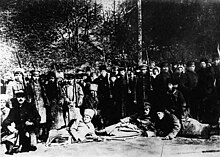| This article includes a list of references, related reading, or external links, but its sources remain unclear because it lacks inline citations. Please help improve this article by introducing more precise citations. (September 2014) (Learn how and when to remove this message) |
| Battle of Kiev | |||||||
|---|---|---|---|---|---|---|---|
| Part of Ukrainian-Soviet War (1917-1921) | |||||||
 A squad of Red Guards who fought in Kiev | |||||||
| |||||||
| Belligerents | |||||||
|
|
| ||||||
| Commanders and leaders | |||||||
|
|
| ||||||
| Units involved | |||||||
| Kiev city garrison | Red Guards | ||||||
| Strength | |||||||
|
2,000 3 batteries |
7,000 armored train artillery battery | ||||||
The Battle of Kiev of January 1918 was a Bolshevik military operation of Petrograd and Moscow Red Guard formations directed to capture the capital of Ukraine. The operation was led by Red Guards commander Mikhail Artemyevich Muravyov as part of the Soviet expeditionary force against Kaledin and the Central Council of Ukraine. The storming of Kiev took place during the ongoing peace negotiations at Brest-Litovsk on 5–8 February 1918 (23–26 January in the Julian calendar). The operation resulted in the occupation of the city by Bolshevik troops on 9 February and the evacuation of the Ukrainian government to Zhytomyr.
Background
The objective of the 1918 Battle of Kiev was to install Soviet power in Ukraine. During the winter of 1917/18 the revolutionary formations of Russia installed Soviet power in governorates of Kharkiv, Yekaterinoslav (modern day Dnipro), and Poltava, Kyiv was next. The general command directed onto Kyiv was under the command of Mikhail Muravyov. On 27 January 1918 the government of Ukraine announced Kyiv under a siege and appointed Mykhailo Kovenko as the military commandant of the city's defence. With the approach of the advancing Soviet forces the city's Bolsheviks instigated an uprising at the Arsenal factory, which was extinguished in seven days on 4 February 1918. The Bolshevik protest in the city greatly eased the advancement of the Soviet forces, drawing several Ukrainian formations out of adjacent provinces. The Kyiv garrison was greatly demoralized by Bolshevik propaganda and Soviet advances across the territory of Ukraine. Ukrainian regiments were depleted, and some either announced their neutrality or were eager to side with the Bolsheviks.
Bolshevik forces attacked the city from Bakhmach and Lubny. On 8 February, the Ukrainian government was forced to abandon the city. On 9 February General Muravyov took control of the city and instituted a reign of Red terror of brutal reprisals against Kyiv's population that would last twenty days.
Aftermath
On same the day Bolshevik forces captured Kyiv, the Central Rada signed a treaty with the Central Powers. Ukrainian People's Army forces under Symon Petliura, along with German and Austro-Hungarian troops, would retake Kyiv on 1 March. The Bolshevik government recognized Ukraine's independence on 3 March. Subsequently, during May to October 1918, peace negotiations were held between Russia and Ukraine.
Order of battle
Muravyov Forces
- Commander in Chief Mikhail Artemyevich Muravyov
- 1st Army Colonel Pavel Yegorov
- 2nd Army Colonel Reingold Berzin
List of formations
- Red Guards of Bryansk 800 soldiers / Russians
- Red Guards of Moscow (Moscow river neighborhood) 200 soldiers / Latvians/ Russians
- Red Guards of Kharkiv 500 soldiers / Jews/ Russians
- Donbas Red Guards of Dmitry Zhloba 300 soldiers / Russians/ Ukrainians/ Jews
- Red Guards of Putilov Factory 60 soldiers / Jews/Russians/ Ukrainians
- 1st Petrograd Red Guard formation 1,000 soldiers / Latvians/ Russians
- Red Guards of Petrograd (Moscow district) 500 soldiers / Latvians/ Russians
- Kharkiv Red Guards of Aleksandr Belenkovich 150 soldiers / Jews/ Russians/ Ukrainians
- Red Cossacks of Vitaly Markovich Primakov 198 soldiers / Russians/ Ukrainians
- Bryansk battery 92 soldiers / Russians
- Armoured train of Moscow 100 soldiers / Russians
- Red Guards formations of local settlements / Jews/ Russians
- Underground workers of Arsenal (Cave monastery) / Russians/ Ukrainians
Composition by nationality: Russians - 88%; Jews - 7%; Ukrainians - 5%
Ukrainian Forces
- City commandant Mykhailo Kovenko
- Haidamaka Host of Sloboda Ukraine Symon Petliura—400 soldiers
- 2nd Cadet School Battalion—110 "Black Haidamakas"
- Free Cossacks formations
- Artillery division—3 batteries
- Sich Riflemen of Halych Battalion Yevhen Konovalets—500 soldiers
- Doroshenko Regiment—200 soldiers
- Remnants of Bohdaniv Regiment Oleksandr Shapoval
- Haidamaka Host of Sloboda Ukraine Symon Petliura—400 soldiers
References
- Orest Subtelny (2009). Ukraine: A History (4th ed.). Toronto: University of Toronto Press. p. 353. ISBN 978-1-4426-4016-0. LCCN 2009504897. OL 24009136M. Wikidata Q104049525.
- Arkadii Zhukovsky, "Ukrainian-Soviet War, 1917–21", in Roman Senkus; Oleh Havrylyshyn; Frank Sysyn; et al. (eds.), Internet Encyclopedia of Ukraine, Canadian Institute of Ukrainian Studies, Wikidata Q87193076
- (in Ukrainian) The world's first monument to Colonel of the UPR Army Bolbochan was unveiled in Kyiv, The Ukrainian Week (5 October 2020)
External links
- 1918 Chronicles. Institute of History of Ukraine.
- War between Russia and Ukraine in 1917-18. Institute of History of Ukraine
- War between Bolsheviks and the government of Ukraine in 1917-18. Military Literature.
- Great Britain. Parliament. The parliamentary debates from the year 1803 to the present time.
- Battle for Kiev: Petliura against Muravyov
50°27′00″N 30°31′24″E / 50.45000°N 30.52333°E / 50.45000; 30.52333
Categories: